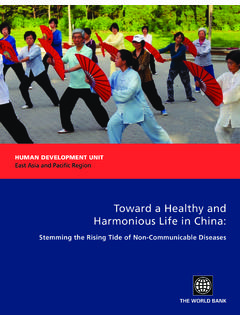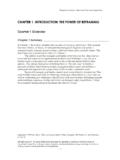Transcription of The Health Report The2003 World - WHO
1 WHOS haping the FutureThe World Health Report 2003 The World Health Report 2003 World Health ORGANIZATIONS haping the FutureThe WorldHealth Report2003 Shaping the FutureWorld Health OrganizationiiThe World Health Report 2003 WHO Library Cataloguing-in-Publication DataWorld Health World Health Report : 2003 : shaping the Health - trends of Health care - trends Health care justice immuno-deficiency syndrome - therapy - prevention and control acute respiratory syndrome -prevention and control diseases - prevention and control , Traffic - - prevention and control : Shaping the 92 4 156243 9 (NLM Classification: WA )ISSN 1020-3311 World Health Organization 2003 All rights of the World Health Organization can be obtained from Marketing and Dissemination, World HealthOrganization, 20 Avenue Appia, 1211 Geneva 27, Switzerland (tel: +41 22 791 2476; fax: +41 22 791 4857; Requests for permission to reproduce or translate WHO publications whether for sale orfor noncommercial distribution should be addressed to Publications, at the above address (fax: +41 22 791 4806;e-mail: designations employed and the presentation of the material in this publication do not imply the expression of anyopinion whatsoever on the part of the World Health Organization concerning the legal status of any country, territory,city or area or of its authorities, or concerning the delimitation of its frontiers or boundaries.))
2 Dotted lines on mapsrepresent approximate border lines for which there may not yet be full mention of specific companies or of certain manufacturers products does not imply that they are endorsed orrecommended by the World Health Organization in preference to others of a similar nature that are not and omissions excepted, the names of proprietary products are distinguished by initial capital World Health Organization does not warrant that the information contained in this publication is complete andcorrect and shall not be liable for any damages incurred as a result of its concerning this publication can be obtained from: World Health ReportWorld Health Organization1211 Geneva 27, SwitzerlandFax: (+41 22) 791 4870 Copies of this publication can be ordered from: design: Marilyn LangfeldInterior design: Steve Ewart and Marilyn LangfeldLayout: Steve Ewart and Reda SadkiPrinted in France2003/15424 Sadag 20000 This Report was produced under the overall direction of Tim Evans (Assistant Director-General) and Robert Beaglehole (Editor-in-Chief).
3 The principalauthors were Robert Beaglehole, Alec Irwin and Thomson other main contributors to chapters were: Chapter One: Colin Mathers, Kenji Shibuya and Claudia Stein. Chapter Two: Andrew Casselsand Michel Thieren. Chapter Three: Paul Farmer. Chapter Four: Bruce Aylward. Chapter Five: David Heymann and Mary Kay Kindhauser. Chapter Six:Ruth Bonita and Srinath Reddy (cardiovascular diseases section); Sarah Galbraith and Douglas Bettcher (tobacco control section); Margaret MacIntyre,Margaret Peden, Mark Rozenberg and Christie Vu (road traffic hazards section). Chapter Seven: Rafael Bengoa, Ties Boerma, Marie-Andr e Diouf,David Evans, William Savedoff, Alaka Singh, Barbara Stilwell, Wim Van Lerberghe and Eugenio Villar contributors to the Report were: Prerna Banati, Michel Beusenberg, Sandro Colombo, Carlos Dora, Joan Dzenowagis, Helga Fogstad,Elangovan Gajraj, Gauden Galea, Claudio Garcia Moreno, Yusuf Hemed, Alan Hinman, Alex Kalache, Rania Kawar, Michele Levin, Alan Lopez,Abdelhay Mechbal, Lembit Rago, Shekhar Saxena, Philip Setel, Cyrus Shahpar, Hans Troedsson and Alice to statistical tables were.
4 Dorjsure Bayarsaikha, Steve Begg, Christina Bernard, Dan Chisholm, Steve Ebener, Emmanuela Gakidou,Yaniss Guigoz, Patricia Hern ndez, Mollie Hogan, Kim Iburg, Chandika Indikadahena, Mie Inoue, Karsten Lunze, Doris Ma Fat, Takondwa Mwase,Fanny Naville, Jean-Pierre Poullier, Chalapati Rao, Darryl Rhoades, Hossein Salehi, Joshua Salomon, Angelica Sousa, Ruben M. Suarez-Berenguela,U Than Sein, Niels Tomijima, Nathalie Van de Maele, Sven Volkmuth, and Hongyi input was received from Assistant Directors-General, policy advisers to the Director-General at WHO headquarters, and many techni-cal staff. Additional help and advice were kindly provided by Regional Directors and members of their Report was edited by Barbara Campanini, assisted by Leo Vita-Finzi. Translation coordination and other administrative and productionsupport was provided by Shelagh Probst, assisted by Laura Pearson and Gary Walker. Proofreading was by Marie Fitzsimmons.
5 The index wasprepared by Kathleen Lyle. Front cover photographs (top row, left to right): reproduced with permission of Ming Pao, China, Hong Kong SpecialAdministrative Region; WHO/P. Viros; PhotoDisc; (bottom row, left to right): WHO/P. Virot; PhotoDisc; Digital from the Director-GeneralviiOverviewixStronger Health systems: the minimum requirementsxCore values for a global Health partnershipxiChapter summariesxiiChapter 1 Global Health : today s challenges1 The global picture3 Life expectancy improves but not for all3 Global mortality patterns4 Surviving the first five years of life7 Child mortality: global contrasts8 Child mortality: gender and socioeconomic differences8 Child survival: improvements for some9 Causes of death in children11 Adult Health at risk: slowing gains and widening gaps12 Global patterns of premature mortality risk15 Adult mortality trends: 15 59 years of age15 Adult mortality: widening gaps17 HIV/AIDS: the leading Health threat17 Mortality and disease among older adults18 The growing burden of noncommunicable diseases18 Injuries a hidden epidemic among young men19 Non-fatal Health outcomes20 Chapter 2 Millennium Health Goals.
6 Paths to the future23 International commitments at the Millennium Summit25A compact to end poverty26 New concepts of poverty and development26 The interaction of Health and development26 Progress and prospects27 The other side of the compact: Goal 830Tr a d e3 1 Development assistance32 Debt32 The Millennium Development Goals in practice32 Who owns the MDGs?33 How flexible is the approach?33 How pro-equity are the MDGs?34 Measuring progress34 Reproductive health34 Health systems strengthening34 The MDGs and WHO35 Defining the place of the MDGs in WHO35 Working with others37 Accelerating progress37ivThe World Health Report 2003 Chapter 3 HIV/AIDS: confronting a killer41 The HIV/AIDS epidemic: a brief overview44A new disease emerges44 The current situation45 The true toll of HIV/AIDS46 Responding to HIV/AIDS: lessons from the past 20 years47 Integrating HIV prevention and care48 Integrated prevention and care: success stories49 Setting a new agenda50A human rights approach50 Dimensions of good HIV/AIDS control51 WHO s work in the HIV/AIDS fight52 Investing in good HIV prevention and care53An emergency response to a global emergency53 Chapter 4 Polio Eradication.
7 The final challenge57A new kind of partnership59 Effectively engaging political leaders60 Finding the funds63 Finding the people65 Prospects for a polio-free future66 Scaling up the delivery of Health services67 Chapter 5 SARS: lessons from a new disease71 The first cases73 Origins and international spread74 Detection and response75 The impact of SARS78 Lessons learnt78 Chapter 6 Neglected Global Epidemics: three growing threats83 Cardiovascular disease: the need to act85 The causes are known87 Policies are available87 Acting now and measuring progress88 Tobacco control: strengthening national efforts91 Guiding tobacco control92 National policies and programmes93 Building national capacity93 Integrating tobacco control into Health systems94 Road traffic hazards: hidden epidemics95 Sharing responsibility for safety97 Mobilizing action97 Injury prevention, safety and treatment98 Integrating road safety with broader policies99 Chapter 7 Health Systems: principled integrated care103 The core principles of primary Health care106 Enduring principles in a changing environment107 Principles in a systems perspective108 The global Health workforce crisis110 Size, composition and distribution of the Health workforce110 Workforce training111 Migration of Health workers112 Paying more and paying differently113 Improving quality: workers and systems114 Responding to the workforce crisis115 Health information.
8 Better but not good enough116 The evolution of Health information116An information system driven by primary Health care116 Improving information systems117 The Health Metrics Network119 Financing Health systems119 Developing sustainable financing120 Unblocking system bottlenecks121 Pro-equity Health systems: government s central role122 Patterns of inequitable access to care123 The goal: universal access125 Government stewardship, community involvement125 Building systems based on principles: WHO cooperation with countries127 Statistical Annex133 Explanatory notes135 Annex Table 1 Basic indicators for all Member States146 Annex Table 2 Deaths by cause, sex and mortality stratum in WHO regions,estimates for 2002154 Annex Table 3 Burden of disease in DALYs by cause, sex and mortality stratumin WHO regions, estimates for 2002160 Annex Table 4 Healthy life expectancy (HALE) in all Member States, estimates for 2002166 Annex Table 5 Selected national Health accounts indicators: measured levels of expenditureon Health , 1997 2001170 Annex Table 6 Selected national Health accounts indicators.
9 Measured levels of per capitaexpenditure on Health , 1997 2001178 List of Member States by WHO region and mortality stratum182 Index185 TablesTable causes of death in children in developing countries, 200212 Table causes of disease burden (DALYs) for males and females aged 15 yearsand over, worldwide, 200214 Table causes of mortality and disease burden (DALYs) among adults,worldwide, 200217 Table Millennium Development Goals, targets and indicators28 Table of adults in developing countries with antiretroviral therapy,by WHO region, December 200245 Table stepwise approach for prevention and control of noncommunicable diseases89 Table of death registration data number of countries with recent usable data 117 FiguresFigure expectancy at birth: developed and developing countries, 1955-20024 Figure distribution of global mortality: developed and developing countries, 20025 Figure of disease burden (DALYs) by age group and region, 20026 ContentsvviThe World Health Report 2003 Figure mortality in the six WHO regions, 20028 Figure in child mortality in three developing countries according tosocioeconomic status9 Figure in child mortality rates by WHO region, 1970 200210 Figure with large absolute reductions in child mortality since 197011 Figure burden (DALYs) among adults (aged 15 years and over) by broad cause,selected epidemiological subregions, 200214 Figure mortality: probabilities of death between 15 and 60 years of age by cause,selected epidemiological subregions, 200215 Figure Trends of adult mortality by sex, selected epidemiological subregions, 1970 200216 Figure Age-standardized rate of years lived with disability (YLDs).
10 Developed anddeveloping countries, 200220 Figure in age-adjusted rate of death from HIV infection, USA, 1987 200044 Figure : episodes in an evolving epidemic46 Figure in the cost of ARV drugs and the number of people in therapy,Uganda, 1997 200250 Figure polio in 1988 and mid-200361 Figure Polio Eradication Initiative: financial support 1988 200564 Figure action plan for the laboratory containment of wild polioviruses,February 200367 Figure cases of SARS worldwide, 7 August 200375 Figure cases of SARS worldwide, 1 November 2002 11 July 200379 Figure attributable to 16 leading causes in developing countries, 200186 Figure mortality patterns: current course and with interventions95 Figure between births accompanied by skilled attendants and numberof Health professionals, 33 developing and transition countries111 Figure in Health spending and incomes by region, 2001119 Figure patterns of Health care deprivation, Uzbekistan, Turkey and Niger122 BoxesBox Sentinel vital registration in the United Republic of Tanzania7 Box The African crisis of child mortality13 Box Population ageing18 Box The burden of mental ill-health19 Box Progress towards the Millennium Development Goals the case of Uganda29 Box Child survival turning knowledge into action30 Box Fighting maternal mortality making pregnancy safer31 Box Millennium Development Goals in eastern Europe33 Box Assuring quality of drugs for HIV/AIDS, tuberculosis and malaria35 Box HIV/AIDS in the European Region47 Box Accompagnateurs.














